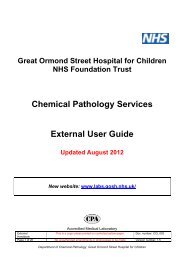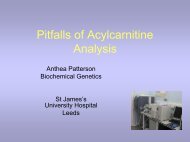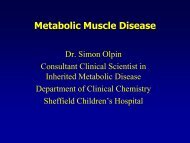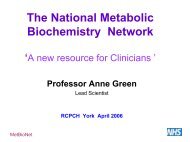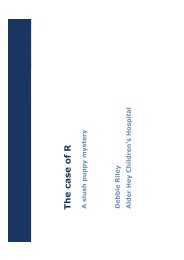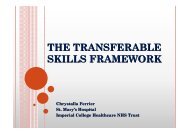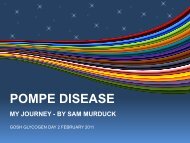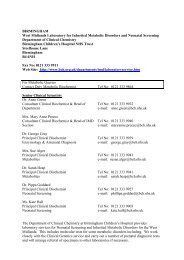GSD 14.10.10.ppt [Compatibility Mode] - MetBio.Net
GSD 14.10.10.ppt [Compatibility Mode] - MetBio.Net
GSD 14.10.10.ppt [Compatibility Mode] - MetBio.Net
- No tags were found...
You also want an ePaper? Increase the reach of your titles
YUMPU automatically turns print PDFs into web optimized ePapers that Google loves.
Glycogen Storage DiseasesPredominately Hepatic <strong>GSD</strong>s:<strong>GSD</strong> I – glucose-6-phosphatase or transport systems in ER<strong>GSD</strong> III – debranching enzyme<strong>GSD</strong> IV – branching enzyme<strong>GSD</strong> VI – liver phosphorylase<strong>GSD</strong> IX – liver phosphorylase b kinase<strong>GSD</strong> 0 – glycogen synthasePredominately Muscle <strong>GSD</strong>s:<strong>GSD</strong> II – acid a-glucosidase<strong>GSD</strong> V – muscle phosphorylase<strong>GSD</strong> VII -muscle phosphofructokinase
<strong>GSD</strong>Hepatomegaly<strong>GSD</strong> 0 No None<strong>GSD</strong> I Yes None<strong>GSD</strong> IINoMuscle symptomsTruncal & proximal muscle weakness.More severe infantile form.<strong>GSD</strong> III Yes Myopathy can occur<strong>GSD</strong> IVHepatic<strong>GSD</strong> VYesNo<strong>GSD</strong> VI Yes None<strong>GSD</strong> VII<strong>GSD</strong> IX liverformNoYes<strong>GSD</strong> XI Yes NoneMyopathy can occurExertional muscle weakness with riskof rhabdomyolysisExertional muscle weakness with riskof rhabdomyolysisMyopathy can occurGlucosehomeostasisFasting ketotichypoglycaemiaSevere (ketotic)hypoglycaemiaNo overt effectFasting ketotichypoglycaemiaNormal until endstage liver diseaseNo effectFasting ketotichypoglycaemiaNo effectOther BiochemistryRaised lipids, urate, lactate,AST/ALT, Abnormal renalbiochemistry includingproteinuriaRaised CK,vacuolatedlymphocytesRaised lipids, AST/ALT, CK maybe raisedRaised AST/ALT, CK can beraisedRaised CKRaised AST/ALTRaised CKFasting ketotichypoglycaemia can CK can be raisedoccurKetotichypoglycaemiaRaise AST/ALT, Abnormal renalbiochemistry including tubularmarkers.
Initial Laboratory Tests for the Investigation ofSuspected <strong>GSD</strong> Blood glucose If hypoglycaemia includeinsulin, FFA, ketones Blood lactate Urate LFTs Lipids CK U&E, tubular proteins,protein/albumin Muscular symptoms only: CK Vacuolated lymphocytes Renal function <strong>GSD</strong> Screen
Glycogen storage disease screen: Minimum 5ml blood in lithium heparin Red cells –glycogen and phosphorylase b kinase White cells –debrancher and phosphorylase-(brancher) Batch consists of 8 samples (manageable no. of assay tubes) Screen takes operator one a week to complete
RBC glycogen Relatively non invasive assessment of glycogen storage Not elevated in <strong>GSD</strong> I, II or IV Most useful for confirmation of <strong>GSD</strong> III <strong>GSD</strong> IX – may be elevated to a lesser degree.
Total Glycogen Debrancher ActivitySonicated Mixed Leucocyte PrepIncubation with PLDTransferase and a-1,6 glucosidaseactivityIncubation with GlycogenNon-specific glycosidic activityBarium hydroxide/Zinc sulphate precipitationGlycogen Debrancher Activity = PLD Glucose – Glycogen GlucosePLD =Phosphorylase Limit Dextran SubstrateGlycogen digested with phosphorylase – leaving chains with fourglucose units after each branch point.NOT COMMERCIALLY AVAILABLE•Assay available in fibroblasts and liver
Phosphorylase b Kinase ActivityWashed Prepared RBCsIncubation of the sample with phophorylaseb to generatephosphorylaseaSamples collected at 0, 7 and 14 minsIncubation with glucose-1-phosphate and glycogen to generate freephosphatePrecipitate proteinsQuantify phosphate using an acid molybdatereaction•Assay available in liver, fibroblasts and muscle
Problems with Enzymatic Diagnosis ofPhosphorylase b Kinase Deficiency Even in confirmed cases total enzyme deficiency may not be seen invitro. Some cases have phosphorylase b kinase deficiency in liver but normalactivity in red cells Muscle forms will not be detected in RBCs Mutations have been found that cause a deficiency in vivo but not in vitro Phosphorylase in leucocytes:Ratio of the active form to total – low in cases of phosphorylase bkinase deficiency. In some cases of phosphorylase b kinasedeficiency the red cell glycogen may be raised BUT not always.
Results which may suggest a defect in thephosphorylase activating system1 2 3 Control rangesRed cells:glycogen: 17 29 681* (10 – 120 mg/gHb)Phos b kinase 15.7 9* ND* (10 – 90 mg/g Hb)White cell enzymes:Phosphorylase a (-AMP) 0.70 0.12* 0.48 (0.3 – 3.7 ug/hr/mg ptn)Total phosphorylase (+AMP) 4.2 2.4 4.6 (2.4 – 10.4 ug/hr/mg ptn)Phos a/total ratio 0.17* 0.05* 0.10* (0.42 – 0.78)
Phosphorylase ActivityWhite cell homogenateIncubation with:Glucose-1-phosphateAMP free GlycogenCaffeinePhosphorylase aIncubation with:Glucose-1-phosphateGlycogenAMPTotal PhosphorylasePhosphate is measured by spectrophotometricmethod. Assay available in liver (and muscle: <strong>GSD</strong> V) Confirmed cases described with very high residual enzyme activity inleucocytes Very labile enzyme
Glycogen Brancher ActivityWhite cell homogenateIncubation with:Phosphorylase aGlucose-1-phosphateBackground linearglycogenolysis +Brancher activityBlank:Phosphorylase aGlucose-1-phosphateInefficientglycogenolysis oflinear glycogenPhosphate is measured by spectrophotometric method. Assay available in liver , muscle and fibroblasts
<strong>GSD</strong> I: Enzymatic Diagnosis<strong>GSD</strong> Ia: Deficiency of glucose-6-phosphatase<strong>GSD</strong> Ib: Deficiency glucose-6-phosphate ER transport protein (T1transport protein)<strong>GSD</strong> Ic: Deficiency of phosphate translocator (T2β transport protein)<strong>GSD</strong> Id: Deficiency of glucose translocator (GLUT 7 transport protein)Glucose-6-phosphatase activity in frozen liver can onlydetect <strong>GSD</strong> IaWhole microsomes from fresh liver provide intact systemtesting the transport proteins and the hydrolase system.
Glucose-6-phosphatase AssayFresh LiverIn sucrose homogenateto preserve microsomesHydrolase & transport proteinsHistone preparation to disruptthe microsomesHydrolase onlyIncubation with G-6-P in acetate buffer pH 5.0 (inhibits non-specific hydrolase)Precipitation of protein and estimation of phosphate –spectrophotometric method•Requires in-patient at GOSH•Problem with controls
Glycogen levels in <strong>GSD</strong>s<strong>GSD</strong>RBCGlycogenTissue glycogenHistology<strong>GSD</strong> 1 Normal Raised liver glycogen PAS pos cyoplasmic glycogen,significant lipid accumulation<strong>GSD</strong> II Normal Raised muscleglycogen<strong>GSD</strong> IIISignificantlyraisedSignificantly raisedliver glycogen<strong>GSD</strong> IV Normal Muscle glycogen concmay be normal<strong>GSD</strong> V Normal Muscle glycogen maybe normalPAS pos lysosomal glycogenPAS pos cyoplasmic glycogen,some lipid accumulationPAS positive amylopectin likecytoplasmic glycogenPAS pos cyoplasmic glycogen<strong>GSD</strong> VI Normal Raised liver glycogen PAS pos cyoplasmic glycogen,<strong>GSD</strong> VII Normal Muscle glycogen maybe normal<strong>GSD</strong> IXOften mild/modraisedUsually raised liverglycogenPAS pos cyoplasmic glycogen,PAS pos cyoplasmic glycogen,
Glycogen Storage Disordersaffecting Predominately theMuscle
<strong>GSD</strong> V Deficiency of myophosphorylase 1: 100,000 Exercise intolerance: rapid fatigue, myalgia and cramps precipitatedby isometric excercise and sustained aerobic excercise. ‘Second wind’ phenonomen with relief of myalgia after a few minutesof rest. Presentation typically in the second and third decade. ~50% patients have episodes of myoglobinuria with risk of acuterenal failure Heterozygotes at increased risk of statin induced myopathy Management: Avoidance of isometric excercise, caution withanaesthasia. Improved exercise tolerance with aerobic training andpossibly creatine monohydrate and sucrose.
<strong>GSD</strong> V: Diagnosis CK Ischaemic forearm test Nonischaemic forearm test Cycle Test: Monitors heart rate to detect ‘second wind’effect. Muscle biopsy: histopathology, enzymology Genetics
Ischeamic forearm Test Patient Preparation: Overnight fast Venous access obtained Baseline sample (-2 min): Ammonia and lactate Procedure:Sphygomanometer cuff on upper arm inflated to above systolic bloodpressure (200 mmHg)Squeezing bulb at 1s intervals for 1 min (amount of effort noted)Cuff remains inflated for further 1 min Samples collected at 0, 2 and 12 min for ammonia and lactateNormal: lactate: > 1.9 mmol/L over baseline in males> 0.6 mmol/L over baseline in femalesAmmonia: >36 mmol/L over baseline males>24 mmol/L over base;inefemales
Ischeamicforearm test:interpretationLactate ResponseAmmonia ResponsePoor Muscle Exertion Flat/suboptimal/normal Flat/suboptimalImpairedmuscleglycogenolysisorglycolysiseg<strong>GSD</strong> V, <strong>GSD</strong>IIIFlat/suboptimalExaggeratedMyoadenylatedeaminase Normal Flat/suboptimalProblems•Lack of exertional effort•Variable protocols•Poor specificity
<strong>GSD</strong> II: Pompe Disease Deficiency oflysosomal acidα-glucosidase (GAA) AR Rare, 1:40,000 Characterised by the accumulation of glycogen inlysosomes of several cell types, particularlycardiac, skeletal and smooth muscle cells.
PompeDisease 2 main forms: Infantile: Presentation in the first few months of life Feeding difficulties Failure to thrive Respiratory infections Hypotonia Hypertrophic cardiomyopathy Almost invariably fatal by 12 months of age (without treatment) Late-onset Pompedisease Presentation from infancy to late adulthood Predominately skeletal muscle dysfunction Muscle weakness (mobility problems) Respiratory problems
Pompe Disease Management• Respiratory therapy• Physiotherapy• Enzyme replacementtherapy•IV administration ofsynthetic enzyme•Some patients respondbetter than others•Some patients developinhibitory antibodiesagainst ERT
Pompe disease Diagnosis Muscle Electromyography (EMG)/nerve conduction studies Muscle strength testing Labs Serum creatine kinase (CK) Alanine and aspartate aminotransferase (ALT/AST)and lactate dehydrogenase (LDH) Histopathology
Diagnosis ofGlycogen Storage Disease Type IIBlood film analysis: vacuolation of lymphocytesMay-Grunewald-GiemsaGiemsaPAS periodic acid / SchiffChildCourtesy of Brian Lake and Glenn AndersonAdultAnderson et al. (2005) J Clin Pathol 58, 1305.
Confirmatory Diagnosis of GlycogenStorage Disease Type IIDemonstration of a deficiency of lysosomal a-glucosidase• Direct: Muscle, fibroblasts• With acarbose: To inhibit interference from Maltaseglucoamylase(MGA)• Leucocytes• Dried blood spotsLess invasive –heel prick, finger stick or blood drawSmall sample requirementConvenientLittle specimen preparationCan be sent in post (cheaper)Stabile at RT during shipping and frozen for long term storageCan be used for newborn screeningLess infectious
Other Myopathic <strong>GSD</strong>s <strong>GSD</strong> VII Deficiency of phosphofructokinase Severe infantile form: Respiratory failure Mild adult form: Exercise intolerance <strong>GSD</strong> IV Muscle Form Infantile neuromuscular form: Presentation at birth with severehypotonia, muscular atrophy and neuronal involvement. Death inneonatal period. Juvenile muscular form: Myopathy +/- cardiomyopathy Mild adult muscular form: Exercise intolerance <strong>GSD</strong> IX Muscle form Deficiency of muscle a subunit (x-linked) or AR forms (possibly γsubunit)
New Biomarkers Serum biotinidase: Consistently mild/moderately elevated in <strong>GSD</strong> Ia & Ib Also variably elevated in some cases of <strong>GSD</strong> III, VI and IX Mechanism unknown Urine Tetrasaccharides:Paesold-Burda et al 2007 Level of Glc 4 ,is elevated in urine and plasma of <strong>GSD</strong> IIpatients by HPLC & electrospray ionisation TMSAn et al. 2000 Analyt Biochem 287, 136, Young et al 2003 Good correlation between plasma and urine levels of Glc 4and clinical response to treatmentAn et al. (2005) Molec Genet Metab 85, 247.
Summary Variable presentation of glycogen storage disorders Initial biochemical investigation can providediagnostic clues Enzymatic diagnosis is not always definitiveparticularly in blood Sometimes biopsy and/or genetic testing is requiredto confirm diagnosis


![GSD 14.10.10.ppt [Compatibility Mode] - MetBio.Net](https://img.yumpu.com/49674680/1/500x640/gsd-141010ppt-compatibility-mode-metbionet.jpg)
